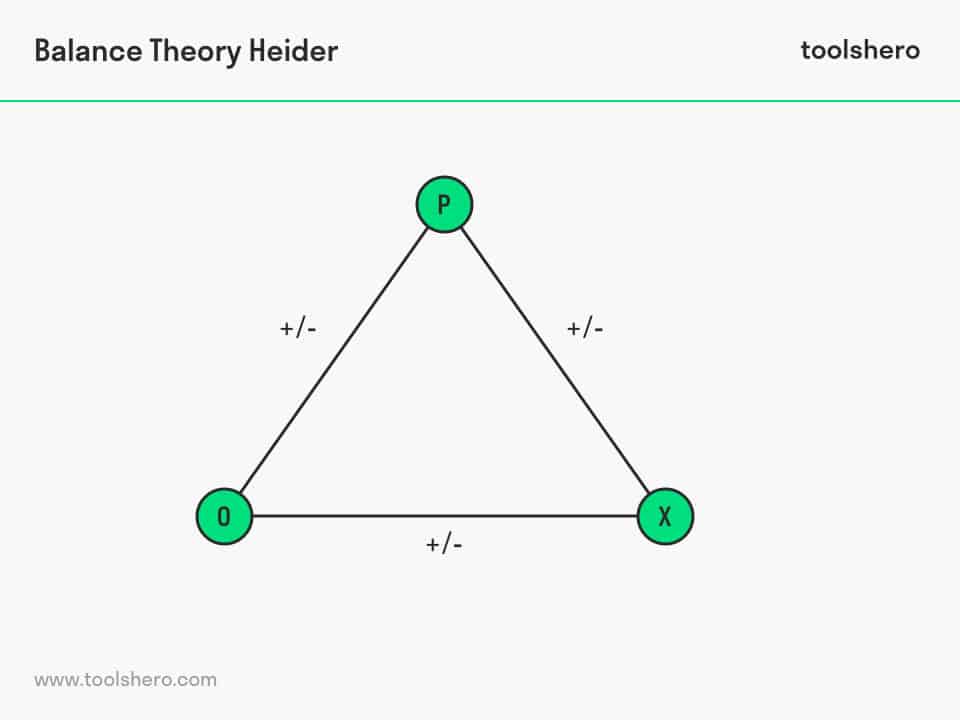Heider’s Balance Theory

Heider’s Balance Theory: this article will provide an explanation of the Heider’s Balance Theory in a practical way. After reading, you will understand the basic concepts of this powerful model for interpersonal relationships as a form of balance for effective and motivational communication.
What is Heider’s Balance Theory?
Heider’s Balance Theory, developed by the social psychologist Fritz Heider, is based on the balance that must exist between interpersonal relationships, or for something specific between two people or more so that a harmony exists between thoughts, emotions and social relationships so that the ideas shared by both subjects coexist without any tension and complication.
This is how this theory of psychology of motivation explains the balance of cognitive consistency as a scale that the human being develops. Heider explains that likes and dislikes are related to balance and imbalance.
The search for coherence between attitudes and relations with others makes the balance neutral, however, when the human being is in disagreement and perceives the imbalance he tends to seek modifications to reach an agreement and thus again to have cognitive harmony of the situation.
Heider’s Balance Theory looks at the relationships between elements that people may consider as belonging to the same group and these may offer the balance of unity that is needed so that these relationships are kept in a balance.
The reactions of each individual are framed within a triangle that Heider calls the P-O-X Model with which one can deduce the positive and negative from what each person perceives with another or with a certain object. You will be able to visualize it further on with its due examples.
Balance (+) Imbalance (-) according to Heider
Social perception is important in order to be able to link balance, harmony, the positive and the negative. This social perception according to Heider plays an important role in determining the balance of unity relationships according to that perception. Relationships can be positive (like- approve) and negative (dislike- disapprove). These relationships are about belonging, positive feelings (close, belonging, similar) or negative feelings (not belonging, not similar, not close).
With the above, Heider developed the P-O-X Model to identify the positive and negative and to form the balance that is needed for harmony between different situations that human beings present and how to live adequately with the differences and conflicts that many times are not shared with other individuals (personal and professional environment) and to be able to reach a positive result at the end of the confrontation and experience.
Model P-O-X
P is a person in whom balance or imbalance occurs, O is perceived a person who is in the environment or situation of P, and X is an impersonal entity or other person or object that participates in the unit. Among these three parts, two types of relationships can be found: attitudes of taste or evaluation relationship and the second one of similarity, participation, proximity among others.
- The relationship between P and O can be positive if P likes O or negative if P dislikes O this is presented as PLO the L as positive representation and in case of dislike or negativity P-LO.
- The relationship between P and X, P feels attraction or taste for X or if P feels rejection or displeasure for X. In the case that X is no longer an impersonal entity it can participate in the process of the POX triad.
The more similarities are found between each element, the more likely the psychological balance will be good, so Heider classifies the feelings into two areas of like or dislike. In most cases if there is a positive unity relationship, there will also be a positive feeling relationship. The same with negative units, these negative relationships are together.
Psychological balance: P+OP (+) > O P< (+) O
It can also extend to things or objects, triadic relationships. If a person likes an object, but does not like another person It is symbolized as: XPXPPOX
- P (+)> X
- P (-)> O
- P (+)> X
Cognitive balance is achieved when there are three positive or negative links with two positive ones. Two positive links and one negative link as in the previous example, thus creating the imbalance.
Multiplying the signs shows that the person will perceive imbalance (a negative multiplicative product) in this relationship, and will be motivated to correct the imbalance in some way. The person can:
- Decide it’s not so bad after all,
- They decide it’s not as big as originally thought, or
- The conclusion I couldn’t have made.
Either of these will translate into psychological balance, thus resolving the dilemma and the satisfaction of unity. (The person could also avoid the object and another person altogether, which reduces the tension created by the psychological imbalance).
To predict the outcome of a situation using Heider’s Balance Theory / Heider’s theory of equilibrium, one must weigh the effects of all possible outcomes, and the one that requires the least amount of effort will be the likely outcome.
Determining whether the triad is balanced in a mathematical way is like this:
- +++= + Balanced
- -+-= + Balancing
- -++= – Unbalanced
Background on the psychology of interpersonal relationships
Fritz Heider focused his work on the study of perception and thoughts in the Psychology of Interpersonal Relations (1958) for the effect and unity of social dynamics. However, several studies have been connected to the importance of concepts about balance. For example, Gestalt psychology of form with the perception of objects where two objects similar to each other form a unit and the experience and dynamics that there is.
The mind then configures the dynamics of perception, thought, memory, intelligence and problem solving, the experiences of each person. These are vital to the development of personal interaction and the environment in which they are.
Heider reflected on the unity and configurations of objects, including social objects where unity is classified by the system of balance between taste and dislike.
With the above you can analyse the following example:
Example between two entities
If Carla (P) likes Bill (O), and Bill has the same feeling of taste towards Carla it will result in the same positive outcome as the system is in balance. But if Carla likes Bill but Bil doesn’t feel the same way and doesn’t like Carla then the imbalance occurs. The balance in these two can be achieved by changing the attitude of one towards the other.
But if Carla (P) and Bill (O) dislike each other, then the system is in balance (two negatives are positive, but it is less satisfactory than when (P) and (O) resemble each other.
Examples among three entities
This type of relationship between three is more complicated, however, with the following example you can better understand the triangle proposed by Heider.
- If Carla (P) likes Bill (O) as the object (Indian food X), then if Bill does not like X, then there is an unbalanced situation and a force will be created to bring the system into a state of equilibrium, for example, a change of attitude from one to Bill (O) or to X.
- If Carla (P) has a negative attitude towards a political party, but her friend Bill (O), whom she admires and loves, is president of the political party she does not like (X) and he recommends her to join. In this situation of imbalance, Carla will change her attitude towards the political party (X) or will change her attitude towards her friend Bill (O). She will give more importance to what is most valuable to Carla.
Conclusion of Heider’s Balance Theory
Heider’s Balance Theory has expanded the study of interpersonal relationships, attitude change, environmental recognition and social cognition among others. This makes the dynamics of a psychological balance in human behavior of great importance for human interaction.
Heider’s Balance Theory can be presented in actions of daily life as personal and professional aspects that each person lives. From a disagreement (sentimental) within a love relationship to a logical agreement with your boss and colleagues to solve a specific situation. These dynamics are often found in the triangle explained above, the idea proposed by Heider is that whether it is a congruence or a discordance, an agreement must always be reached for the result to be positive.
The conflict of incongruence by people and factors that are presented to a given situation is also vital to have a mechanism of confrontation and change to the problem. It is good to face these situations with moderation and harmony since the conflict is sometimes also necessary to know and accept the perspectives of the other people involved.
Harmony is the balance that must be kept in interpersonal relationships so that the dynamics that arise can be addressed in a calm manner by each participant. The communication in this psychological and social field that this model offers us makes interpersonal relationships be analysed from the likes and dislikes and these are reflected to improve the dynamics and the result of these.
The solution for a negative result between the existing interpersonal relationship proposed by the theorist Hieder is the creation of forces to reach the state of harmony that is needed. The dynamic characters change or the relationships of unity will be those that change with respect to the action or cognitive attitude. This means that the individual is able to modify his perception of the environment and to change it, but if it is complicated to do so, the individual reorganizes his perception according to the desired balance.
Heider also has the theory of attribution which is linked to his theoretical thought of the psychology of interpersonal relationships and the behavior that individuals exercise in certain situations the “naive psychology”.
It’s your turn
What do you think? Do you think that Heider’s Balance Theory is important for interpersonal relationships? Have you put Heider’s triangle into practice by putting in order the feelings of like or dislike you present in any situation? Is Heider’s Balance Theory relevant to control psychological relationships in the workplace?
Do you have anything else to add or any suggestions?
Share your experience and knowledge in the comments box below.
More information
- Woodside, A. G., & Chebat, J. C. (2001). Updating Heider’s balance theory in consumer behavior: A Jewish couple buys a German car and additional buying–consuming transformation stories. Psychology & Marketing, 18(5), 475-495.
- Woodside, A. G. (2004). Advancing means–end chains by incorporating Heider’s balance theory and Fournier’s consumer–brand relationship typology. Psychology & Marketing, 21(4), 279-294.
- Adejumo, G., Duimering, P. R., & Zhong, Z. (2008). A balance theory approach to group problem solving. Social Networks, 30(1), 83-99.
How to cite this article:
Ospina Avendano, D. (2020). Heider’s Balance Theory. Retrieved [insert date] from Toolshero: https://www.toolshero.com/psychology/heiders-balance-theory/
Published on: 15/06/2020 | Last update: 04/05/2022
Add a link to this page on your website:
<a href=”https://www.toolshero.com/psychology/heiders-balance-theory/”>Toolshero: Heider’s Balance Theory</a>













